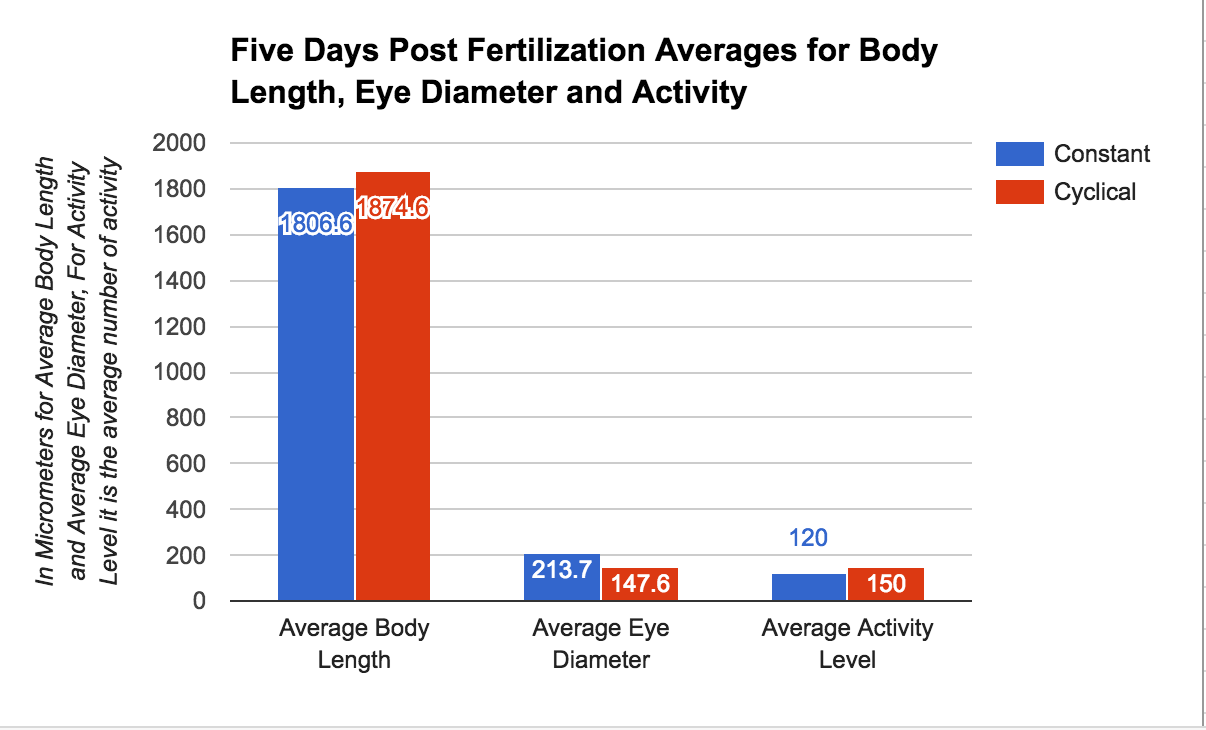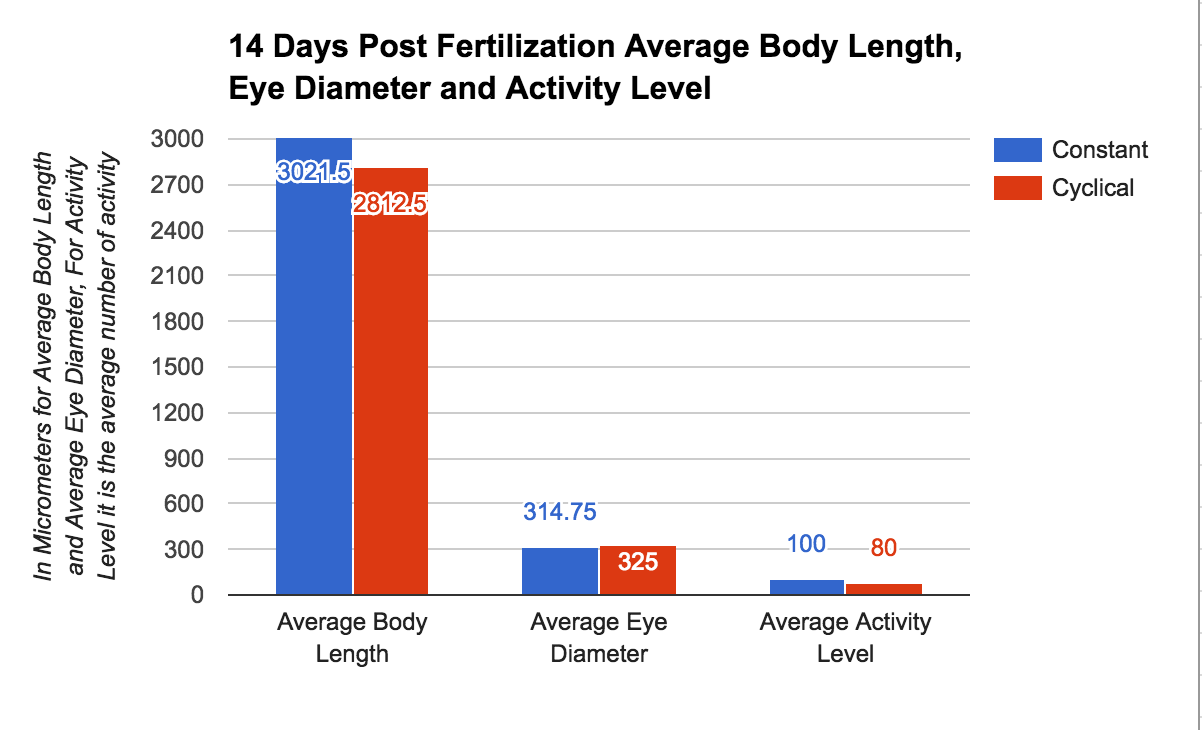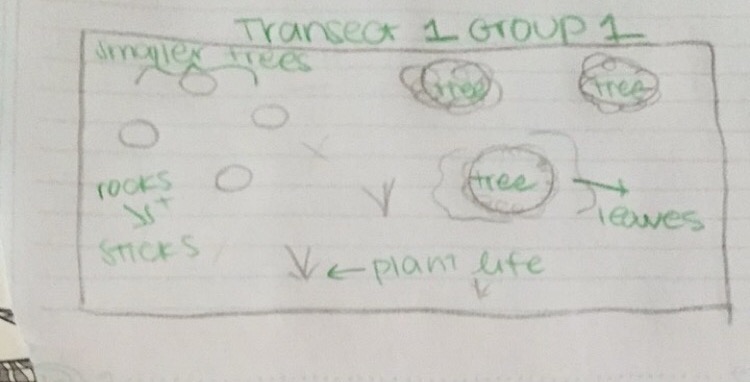User:Kathryn A. Sloane/Notebook/Biology 210 at AU
Zebrafish Lab Bio Lab 210 Section 4 March 23 2016
Experiment Observe Zebrafish larvae over a two week period.
Purpose To determine what affect abnormal light rearing (24 hour light) has on Zebrafish development.
Materials and Methods -Obtain 20 healthy (clear, not a cloudy white color) zebrafish larvae and place them in individual wells of two trays, ten in each tray, one per well. Each well was also filled with 10 mL of deerpark water. One tray is the control (Zebrafish under normal cyclic light conditions, fish 1-10) the other is the tray being tested (24 hours of light, fish 11-20). -Use a dissecting microscope to determine what stage each individual larvae is in (hours post-fertilization). Place fish in respective areas of classroom. (Cyclic light on tray, 24 hour light under lamps). -Come back every day to check on the development of fish, once embryos have hatched feed larvae 15 microliters of brine shrimp solution. On days 1, 5, 7, and 14 fish are observed and charted in excel. Each fish is checked on these specific requirements: alive, dead, still developing, activity (stimulated and non-stimulated), eye size, and body size. -Live semi-developed larvae fixed on days 5 and 14, to be observed later.
Results In order to determine the results my lab partner decided to assign a series of numbers to each fish. 0 if it was dead, 100 if it was alive but not moving, 200 some movement, 300 very actively moving. She then compiled the results into graphs. Combined with the eye size of each fish and the length of the fish in micrometers Here are the graphs fro day 5 and 14.
We lost all but two of our fish because of a lab error, so the results may not be completely accurate but based off of the information given it can be noted that the activity, eye size, and body length are significantly smaller in the fish that were raised under 24 hours of light.
KS
Feb 3 2016
Bio Lab 210
Section 4
Transect 1
Group 1
Goal of the week To be able to determine different types of eukaryotic unicellular organisms (protists) using a dichotomous key and to perform serial dilutions to set up the growth of bacteria colonies.
Procedure Set up of the hay infusion-my partners and I added 10 grams of substance from our transects, this including leaves, twigs, branches, soil, acorns, and other plant life. We then added 500 ml of water and then .1 gram of dried milk powder. After that we put on the lid and shook the jar for around 60 seconds, allowing the mixture to mix together. We then let it sit for a week (with the lid off, exposed to the air) and the next class we took samples of water from near the top, middle, and bottom and put them under the microscope in order to study the different life forms existing there and determining what they were by using a dichotomous key. After that we preformed a serial dilution and set up different agar plates (based on concentration of hay infusion and type of agar plates, tet + and normal nutrient based plates).
Description of Hay Infusion Set up included adding about 10 grams of soil and other things (such as leaves and branches) from transect, adding 500ml of water, and then adding about .1 gram of dried milk powder. Then we put the lid on the jar and shook it, and then let it sit for a week without the lid on. A week later we observed the hay infusion cultures, observations: no observable organisms, gross and dingy looking, smells bad, sediment that is left has sunk to the bottom to form a sort of muck, murky, some leaves still green (though most are brown and breaking apart), a layer of film is coating the top of the hay infusion.
File:Hay infusion top view.jpg
Protist Sample Location
The protist samples came from each section of the hay infusion, one near the surface, one from the middle, one very close to the layer of "muck" at the bottom.
Top: (Oedogonium) File:Oedogonium top.jpg
Middle: (Colpidium) File:Colpidium middle.jpg
Bottom: (Peranma) File:Peranma top
KS
Jan 25 2016 Bio Lab 210 Section Four Transect 1 Group 1
Abiotic Factors
-Water
-Wind
-Soil
-Rocks
-Temperature
Biotic Factors -Leaves -Oak Trees -Acorns -Flowers -tree branches (sticks)
Description of Transect: Plot of land the soil is hard/compact because of the temperature (28 degrees) the soil underneath the frozen top layer is loose and cold. 11 mph winds occurring (at the time we were there 5:30-6:00pm). Three larger oak trees and several smaller trees. There were many twigs, sticks, and tree branches littering the ground. There were also clumps of decomposing leaves and fallen acorns scattered across the ground. There were some remnants of plant life that had been growing there, flowers, small bushes and patches of clover. The air was cold and the sky was dark given the time frame.
KS


